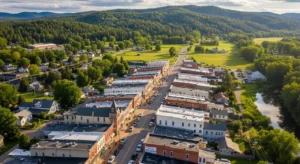For millions who know him from American Pickers, Mike Wolfe has always been more than a television personality. His charm, eye for vintage treasures, and deep respect for history have made him a household name. Yet beyond the TV spotlight, Wolfe’s newest journey, known as the Mike Wolfe Passion Project, is something far more meaningful. It is not just about collecting antiques but preserving the soul of America’s small towns and forgotten architecture.
Introduction to the Passion Project
The Mike Wolfe Passion Project began as a heartfelt effort to give new life to neglected spaces across rural America. While his career in picking exposed him to countless relics of the past, this project reflects his mission to restore not only buildings but also the sense of identity that once defined these communities.
Wolfe’s project revolves around the belief that every town tells a story through its architecture, craftsmanship, and cultural legacy. Instead of letting these landmarks decay, his passion is to revive them for future generations. This is not just a construction effort but a movement of preservation, sustainability, and community revitalization.
The Story Behind Mike Wolfe’s Vision
Mike Wolfe has always been captivated by history and storytelling. Long before he became a television figure, he traveled through backroads, discovering forgotten treasures. The Mike Wolfe Passion Project grew from his realization that America’s architectural heritage was disappearing faster than the items he collected.
Through his preservation initiative, Wolfe aims to bridge the gap between nostalgia and progress. His focus is on restoring historical buildings, transforming them into functional, modern spaces while keeping their original charm intact. These projects are as much about saving structures as they are about reigniting pride within small-town America.
Core Components of the Passion Project
The Mike Wolfe Passion Project stands on three main pillars: preservation, restoration, and community engagement.
-
Preservation of Architecture:
Wolfe identifies old structures that have historical or cultural importance. Instead of demolishing them, he leads efforts to maintain their authenticity through careful craftsmanship and sustainable materials. -
Restoration and Reuse:
Rather than turning these buildings into museums, he reimagines them as usable spaces — cafes, boutiques, art studios, or community hubs. This approach breathes life into neighborhoods while creating local economic opportunities.

-
Community Involvement:
Each restoration involves local artisans, builders, and historians. The project highlights collaboration and encourages residents to take pride in their heritage.
This combination ensures that the Mike Wolfe Passion Project is not just about saving old walls but nurturing entire communities.
Sustainability and Innovation
A key part of the project’s success lies in its focus on sustainability. Wolfe promotes eco-friendly restoration practices such as reusing original materials, reducing waste, and integrating modern green technologies.
From reclaimed wood to energy-efficient lighting, every element reflects his vision of harmonizing history with innovation. This approach not only helps the environment but also preserves the craftsmanship of past generations, making each restored site a model of responsible development.
Funding Models and Partnerships
The funding for the Mike Wolfe Passion Project comes from multiple sources — private investors, preservation grants, and local partnerships. Wolfe often collaborates with small-town councils, historical societies, and nonprofit organizations to ensure the financial sustainability of each restoration.
By combining creative funding models with community participation, the project encourages local ownership. This strategy transforms passive observers into active contributors, ensuring the buildings remain vibrant long after the renovations are complete.
Challenges and Lessons Learned
Like any large-scale preservation effort, the Mike Wolfe Passion Project faces several challenges. Some towns lack funding or modern infrastructure, while others require navigating complex preservation laws. Weathering, structural decay, and bureaucratic delays can slow progress.
However, Wolfe’s persistence and experience as a builder and storyteller help overcome these hurdles. His philosophy is simple: every challenge is an opportunity to learn, adapt, and inspire others. The lessons from each project have paved the way for smoother collaborations and better restoration practices across future sites.
Impact on Communities and Cultural Heritage
The impact of the Mike Wolfe Passion Project reaches far beyond physical buildings. These restorations stimulate local economies by attracting tourism, inspiring entrepreneurship, and fostering a renewed sense of belonging.
When an old structure transforms into a thriving business or public space, it becomes a symbol of resilience. Local residents often share how these projects reignite their town’s pride and strengthen community bonds. Through every restored brick and wooden beam, the project revives the story of America’s small towns — one building at a time.
Case Studies: Towns Transformed by Wolfe’s Vision
-
Columbia, Tennessee:
Once a quiet town, Columbia now stands as a vibrant example of Wolfe’s preservation philosophy. He played a key role in restoring vintage storefronts and revitalizing its downtown area. -
LeClaire, Iowa:
Known as Wolfe’s original base of operations, LeClaire showcases how historic preservation can drive tourism and economic growth. Restored buildings now house thriving local businesses and art galleries. -
Nashville, Tennessee:
Wolfe’s influence is visible in several projects across the city, where he supports small businesses that value historic design. Each restored property adds to Nashville’s cultural identity and urban charm.
How You Can Get Involved
One of the most inspiring aspects of the Mike Wolfe Passion Project is that it welcomes public participation. Supporters can contribute by volunteering, donating to preservation funds, or advocating for local restoration initiatives.
Whether you are an architect, historian, artist, or simply someone who loves old buildings, there are many ways to help. Wolfe’s message is clear: saving history is a shared responsibility, and every contribution matters.
Measuring the Project’s Legacy
The true success of the Mike Wolfe Passion Project lies not in the number of buildings restored but in the lives and communities it touches. Each restoration becomes a living legacy that reminds people of where they came from and inspires them to value authenticity in a world that often prioritizes new over meaningful.

Through dedication, creativity, and collaboration, Mike Wolfe continues to prove that history is not something to be forgotten but something to be lived, shared, and preserved. His journey shows that when passion meets purpose, real change happens — one building, one town, and one story at a time.
Conclusion
The Mike Wolfe Passion Project is more than a preservation initiative; it is a movement to reconnect people with their roots. It transforms decaying structures into thriving landmarks and forgotten towns into vibrant communities.
Wolfe’s efforts remind us that preservation is not about living in the past but honoring it while building a better future. Through his passion project, he continues to inspire others to see beauty in history and hope in restoration — proving that true legacy is built on preserving what matters most.






















Leave a Reply